It’s a bit of a conundrum really. Maybe more than we think it is.
Football, like most team sports, is romanticized by its fans. The element of novelty, more often than not, takes center stage in any debate involving the sport – precisely why people go against ‘moneybags’ in modern football, the influx of Middle East businesses in European football and the never-ending involvement of politics in South-East Asian football, more pertinently in Malaysia.
It’s also why naturalization – despite Malaysia’s continuous struggles on the international scene – largely remains an unpopular concept within the country. Despite the modern world’s evolution and constant desire to transcend beyond just borders, football is one of those things that would continue to revitalize classic terms like patriotism and purity in a particular social fabric.
A small window though, seems to have opened in Malaysia.
For those who were at the Shah Alam Stadium last week, your comprehension of Malaysia’s performance may be tainted by the crowd violence that took place towards the end of the game, but a simple flashback would remind you of Junior Eldstal’s rock-solid performance, as well as Matt Davies’ encouraging debut. I don’t think it’s unfair to suggest that both men – who are half-Malaysians – were arguably Malaysia’s best players on the pitch, that night.
Let’s not forget Brendan Gan, the Kelantan FA midfielder who is currently nursing an ACL injury. He was instrumental in Kelantan’s revival under George Boateng in 2013, and he’s half-Malaysian as well.
Even the most fanatic Malaysian football fan has slowly accepted Junior, Brendan and Matt as worthy of donning the national colours, but that process was largely assisted by the exclusivity of their cases. We’re talking about nothing but three individuals with a decent amount of Malaysian heritage in them.
But here is where a paradigm shift is on the verge of taking place. As of now, seven other half-Malaysians are looking to break into the Malaysian market, and they face a battle that’s bigger than the legal barrier. A battle to be accepted into the Malaysian football fabric. The conservative football fans will visibly be against it, but contrary to popular perception, their arrival could very well provide a respite for the local football scene.
WHO ARE THESE GUYS?
- Curran Ferns | 22 year-old | Central Midfielder | Australian-Malaysian
- Dan Ting | 23 year-old | Left-Back | English-Malaysian
- Kevin Gunter | 23 year-old | Central Midfielder | Swiss-Malaysian
- Nick Swirad | 24 years-old | Central Defender | English-Malaysian
- Sam Somerville | 21 years-old | Goalkeeper | English-Malaysian
- Shazalee Ramlee | 21 years-old | Central Midfielder | Australian-Malaysian
- Darren Lok | 24 years-old | Striker | English-Malaysian
Six out of the seven players (except for Darren Lok) are already in Malaysia as of now, and they were even present at the Malaysia-Saudi Arabia game last weekend. Better still, they spoke extensively with Junior and Matt Davies after the game, assisted by their agent, who is a former Australian international, Scott Ollerenshaw. Darren on the other hand, is looking to push for a move next year, with the April transfer window presenting a good opportunity for Malaysian teams to swoop in.
ARE THEY GOOD ENOUGH TO PLAY IN MALAYSIA?
Frankly speaking, we don’t know. But it’s a 50-50 situation and if Junior, Brendan and Matt are to be taken into consideration, chances are that they would end up fitting in really well. Some of these individuals may have only played in the lower leagues of England or Australia but they possess a fulcrum that’s perhaps equal if not stronger than the Malaysian footballers.
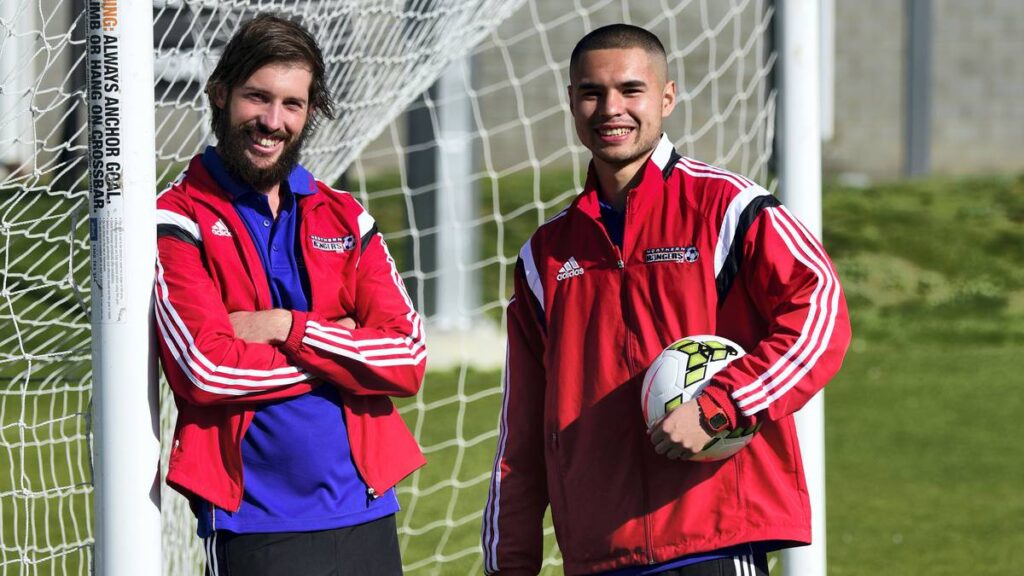 A huge part of being a footballer, depends on talent and sheer technical ability – that’s a given. But when it involves the mental side of things, the likes of Darren, Sam and even Nick possess elements that would unsurprisingly surpass their soon-to-be compatriots. When it comes to professionalism and a winning mentality, these individuals will undoubtedly stand out. Scott Ollerenshaw, had a better analogy for it.
A huge part of being a footballer, depends on talent and sheer technical ability – that’s a given. But when it involves the mental side of things, the likes of Darren, Sam and even Nick possess elements that would unsurprisingly surpass their soon-to-be compatriots. When it comes to professionalism and a winning mentality, these individuals will undoubtedly stand out. Scott Ollerenshaw, had a better analogy for it.
“If you turned up to an empty stadium when Junior Eldstal was playing, you would hear his voice non-stop,” he said. “People who have played at a decent level will realize how important talking and communication is during the game. Unfortunately, Malaysian players hardly talk during games,” he added.
Sam Somerville has had extensive training stints with Premier League powerhouses like Chelsea and Arsenal, while Dan Ting was part of the Crewe Alexandra set-up as a youth player. We’re talking about clubs with a proper blueprint for youth development and while the players they produce may differ in terms of technical ability, their mentality is usually uniform across the board.
Scott also confirmed that several Malaysian clubs have already expressed their interest in acquiring the services of these players, though the identity of those teams will not be revealed until the move nears completion. But considering that Kevin Gunter, Curran Ferns and even Sam Somerville have had training stints with Johor DT, it wouldn’t be surprising if the Southern Tigers are amongst the sides keen on making a move.
For now though, it purely depends on whether the Immigration Department get their applications approved.
BUT ARE THEY ‘MALAYSIAN’ ENOUGH?
Well legally, if they are granted a Malaysian passport, there should be no issues in accepting them as equal Malaysians. The procedural arguments will be adjudicated by the immigration officers themselves, but even then, we’re talking about individuals with a certain degree of Malaysian heritage in them.
What exactly makes us a Malaysian? Is it the fact that we were born in Malaysia? Or is it the fact that we practice Malaysian values and culture? But aren’t those things privileges that are by-products of the birth lottery? These yardsticks are relative and arbitrary in nature.
 But when you see Junior battling like a warrior on the pitch, defending the Malaysian badge with honour, it becomes rather redundant to even have conversations on whether these individuals are ‘Malaysian’ enough. When a half-Malaysian like Matt Davies works harder on the pitch, compared to most local players out there, does it really makes sense to question their authencity.
But when you see Junior battling like a warrior on the pitch, defending the Malaysian badge with honour, it becomes rather redundant to even have conversations on whether these individuals are ‘Malaysian’ enough. When a half-Malaysian like Matt Davies works harder on the pitch, compared to most local players out there, does it really makes sense to question their authencity.
As long as they possess a Malaysian passport, pay tax like every ordinary citizen, and display combative attributes every single time they feature for the national team, the likes of Junior, Matt and possibly even Darren in the near future, are legitimate Malaysians.
IS THERE A TANGIBLE BENEFIT FOR MALAYSIAN FOOTBALL
The idea of pure Malaysian players is one that’s largely romantic, but no longer practical, when there are deeply-rooted issues within the local football scene. The world is opening it’s borders. We’re evolving into a global village, and plenty of footballing are going down the same path.
Germany has Jerome Boateng (half-Ghanian) on the squad ranks while his brother Kevin-Prince Boateng plays for Ghana, despite having very minimal affiliation with the country. Zesh Rehman, who currently plays for Pahang in the Malaysia Super League, opted to play for Pakistan despite being born and raised in England for all his life. He’s even the Pakistan’s national team captain at this point, and remains a cult hero back home.
For a more realistic comparison, take a look at the USA National Team, which has a host of mixed-heritage players in it. Ventura Alvarado is one, spending all of his life in Mexico, but opting to play for the USMNT. Alfredo Morales, who grew up in Germany and currently plays for FC Ingolstatd, also opted to play for the USMNT, by virtue of having an American father. Bobby Wood and Aron Johansson are other examples of German-born players in the USMNT.
Has it worked for them? On a short-term level, yes. Six to seven years ago, you would have never expected to see them beat the likes of Netherlands and Germany. You would have never expected them to be treated as a true force to be reckoned with, in international competitions. Is it a long-term solution? Maybe no. The youth development program in the US is still growing with time. But does this allow them to compete internationally for the next 3-5 years? Absolutely.
That’s the similar approach that Malaysia needs to go towards. Obviously, youth development should be at the forefront of solving the deepest issues in M’sian football. A reform is also required, if we speak extensively about FAM. But while those things take place, there needs to be a safety net to at least hold Malaysia for the next 5 to 10 years.
Not every single one of these half-Malaysian players will immediately secure a national team spot. It won’t be entirely unfair to even suggest that some local players will probably be better than them, technically. But if they are able to bring a strong mentality and influence the local football scene with their level of professionalism, then there’s no reason to not see this trend continuously growing. And like it or not, it’s also a timely reminder for local footballers to buck up and face the competition for spots, which is about to get a lot more tougher.
Other posts by Keeshaanan Sundaresan
